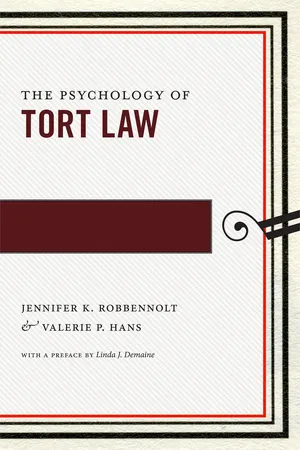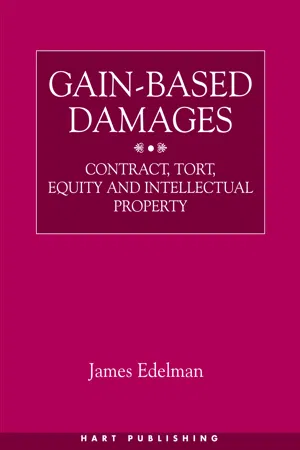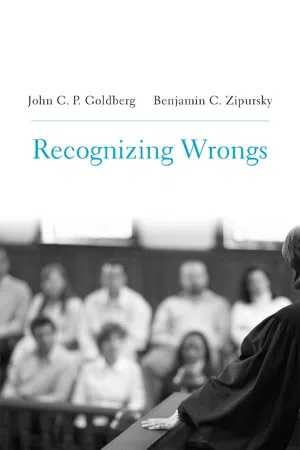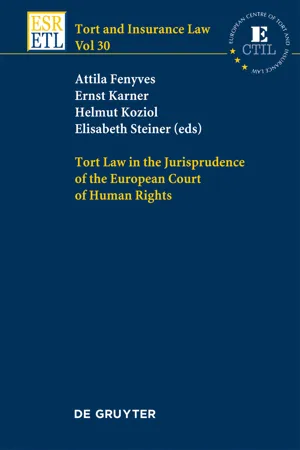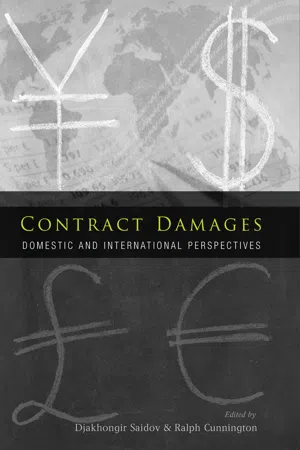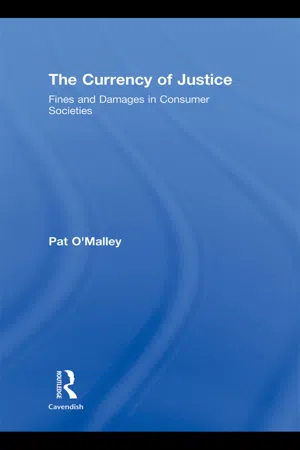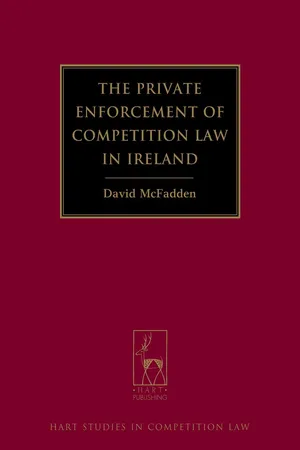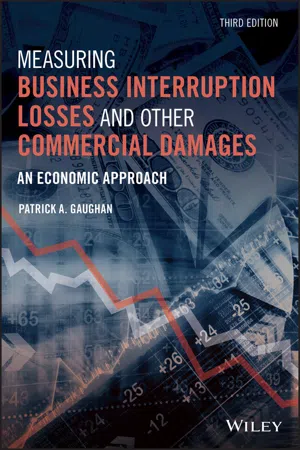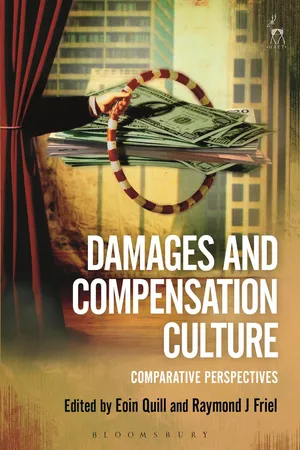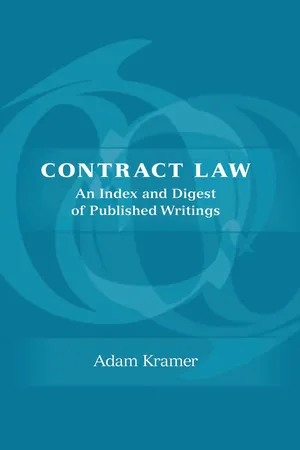Law
Compensatory Damages
Compensatory damages refer to the monetary award given to a plaintiff in a lawsuit to compensate for the actual losses or injuries suffered. These damages aim to restore the plaintiff to the position they were in before the harm occurred, covering expenses such as medical bills, property damage, and lost wages. They are distinct from punitive damages, which are intended to punish the defendant.
Written by Perlego with AI-assistance
Related key terms
1 of 5
12 Key excerpts on "Compensatory Damages"
- eBook - PDF
- Brian L. Cutler(Author)
- 2007(Publication Date)
- SAGE Publications, Inc(Publisher)
181 D AMAGE A WARDS Damage awards function as a remedy for wrongdoing in civil lawsuits; they constitute money awarded to an injured party as compensation for injuries or other losses (“compensatory” damages). They can also serve as punishment for the wrongdoer (“punitive” dam-ages). These awards are made mostly by juries and occasionally by judges who previously determined that a wrongdoer was liable for damages. Determining damages—especially for intangible injuries such as pain and suffering—can be difficult, and juries have been criticized for issuing awards that seem extrava-gant and unpredictable. Although some of the criti-cisms are unfounded (e.g., jurors are not especially sympathetic toward plaintiffs), jurors occasionally do experience difficulty in applying jury instructions and following procedures that blindfold them to the conse-quences of their verdicts. Reforms intended to address these issues should be based on empirical analysis, and psychologists are well-positioned to provide the rele-vant data. Various Kinds of Damage Awards Damage awards are of two general types, compen-satory and punitive, and they serve different functions. Compensatory awards are intended to return an injured person or entity (e.g., a business, agency, or corporation) to pre-injury levels of functioning—that is, to restore that party to the position it was in prior to the injury or harm. For example, a person injured in an automobile accident may receive a compensatory damage award to cover any medical costs, lost wages, and pain and suffering related to the injuries sustained in the accident. As another example, a business may receive a compensatory damage award to cover any revenues lost to competitors involved in price-fixing, trademark infringement, or sharing of trade secrets. Compensatory damage awards are themselves of two sorts: economic and noneconomic. Economic damages are intended to cover the financial or eco-nomic costs incurred by the injured party. - eBook - ePub
- Jennifer K Robbennolt, Valerie P Hans, Jennifer K. Robbennolt, Valerie P. Hans(Authors)
- 2016(Publication Date)
- NYU Press(Publisher)
3 The Sabia family then began what would become a seven-year odyssey through the labyrinth of a medical malpractice lawsuit. Along the way, the question of how to put a price on the injury done to Little Tony came up again and again.The major remedy available to tort plaintiffs is money damages. Some scholars debate whether money damages are always the most appropriate remedy for plaintiffs who are injured. They ask why the tort system does not offer other remedies—such as apology, punishment, or community service—to those who are injured through a defendant’s tortious actions.4 Despite these concerns, awarding money damages is intended to serve both the deterrence and the corrective justice goals of the tort system.5 Plaintiffs are entitled to Compensatory Damages that compensate them for the losses they experienced as a result of the defendant’s actions or omissions. The goal of Compensatory Damages is often described as an attempt to make the plaintiff “whole,” restoring the plaintiff as much as possible to a pre-injury state.6 In some cases involving particularly egregious behavior on the defendant’s part, plaintiffs may also be entitled to recover punitive damages that are designed to further deter harmful behavior and to punish the defendant.Compensatory Damages are categorized into economic (or special or pecuniary) and noneconomic (or general or nonpecuniary) damages. As in many cases, the lawyers in Little Tony’s medical malpractice case requested both economic and noneconomic damages. When it comes to economic damages, the amount needed to appropriately compensate the plaintiff can sometimes be relatively straightforward to determine. It might be calculated, for example, as the replacement or repair cost for a car damaged in an accident. Plaintiffs may also request compensation in the form of economic damages for lost wages, lost profits, medical bills, and other past or future financial consequences linked to the defendant’s tortious conduct.In calculating these damages, there is opportunity for psychological and contextual factors to come into play. Consider, for example, forecasting future plaintiff losses. These estimates are usually dependent on predictions about how long the plaintiff’s symptoms will persist, whether a plaintiff’s disabilities are likely to be permanent, or a plaintiff’s likely career prospects, predictions that may be influenced by a variety of psychological phenomena. Similarly, it may be difficult for plaintiffs and fact finders to distinguish between losses attributable to a plaintiff’s preexisting conditions and losses due to the defendant’s wrongdoing.7 - eBook - ePub
Construction Law
An Introduction for Engineers, Architects, and Contractors
- Gail Kelley(Author)
- 2012(Publication Date)
- RSMeans(Publisher)
CHAPTER 21
CALCULATIONS OF DAMAGES
The amount of money awarded to a plaintiff who has prevailed on a claim of loss or injury is referred to as the plaintiff’s damages . Most claims on construction projects are for breach of contract, and the damages are compensatory, which means they are designed to put the nonbreaching party in as good a position as it would have been in if the contract had been performed according to its terms. The rationale used to determine appropriate damages is referred to as the measure of damages .Typically, the measure of damages for breach of contract is the nonbreaching party’s expectation interest—in other words, how the party expected to benefit from the contract. Courts also refer to this as the party’s benefit of its bargain . A party is entitled to have the benefit of what it contracted for; when one party has lost the benefit of its bargain because the other party breached the contract, a court will try to restore that benefit. Generally, the rights of the parties are fixed at the time the contract was breached, and damages are measured as of that time.21.1 Compensatory Damages
Compensatory Damages for a breach of contract can include both direct costs and consequential costs that were reasonably foreseeable at the time the contract was executed (signed). Direct costs are typically costs that can be identified with and charged to a particular cause. For example, if the owner improperly rejected work, the contractor’s direct damages would be the cost to redo the work. Likewise, if the owner had to hire another contractor to repair defective work, the cost of the repair would be a direct cost. Proof of damages does not necessarily require exact calculations; it is usually acceptable to perform a reasonable estimate.21.1.1 Consequential Damages
Consequential damages, also known as special damages - eBook - ePub
Gain-Based Damages
Contract, Tort, Equity and Intellectual Property
- James Edelman(Author)
- 2002(Publication Date)
- Hart Publishing(Publisher)
1
The Nature of “Damages”
INTRODUCTION
In the vast majority of cases at common law in which damages are claimed, they are sought in order to redress loss which has been suffered. By redressing loss these awards aim to compensate the claimant and are often termed “Compensatory Damages”. So common are Compensatory Damages at common law that compensation seems to some to be the sole purpose of common law damages awards. The supporters of this view argue that “where no loss has been suffered no substantial damages of any kind can be recovered”.1 In German law, it is the case that damages awards for wrongs do operate exclusively to compensate for loss.2 However, this first chapter is devoted to demonstrating the falsity of this view in English common law and breaking the link between damages and compensation. Although common law damages are often concerned with compensating a claimant, they can (and do) have different goals. This chapter will show that “damages” means nothing more specific than a monetary award given for a wrong.3Although this book is concerned with damages awards based upon gain, this chapter will defer discussion of these gain-based awards and, in order to demonstrate that damages awards can be based on principles other than compensating for loss, the focus will be upon a simpler, less contested and better known example. This is the remedy of exemplary damages: an award of damages which, it is universally acknowledged, is expressly not concerned with loss to a claimant. The primary purposes of exemplary damages are to punish a defendant and to create an example to deter the defendant and other potential defendants from similar conduct.A discussion of exemplary damages might seem to be an odd starting point for a defence of gain-based awards for wrongs. But the reason for beginning in this way is that the single greatest obstacle to the acceptance of gain-based damages is the intuitively attractive, but false, notion that damages must be tied to compensation. Exemplary damages have the following in common with gain-based damages: they are calculated other than by reference to the claimant’s loss. For nearly 40 years English law has been attracted by, and has nearly succumbed to, the notion that exemplary damages are anomalous and should be eliminated for this very reason. A recent study by the Law Commission and a very recent decision of the House of Lords has restrained, perhaps even reversed, the English flirtation with this view. The rehabilitation of exemplary damages is the essential foundation for the recognition of the legitimacy and utility of other kinds of non-Compensatory Damages. - eBook - ePub
- John C. P. Goldberg, Benjamin C. Zipursky(Authors)
- 2020(Publication Date)
- Belknap Press(Publisher)
In these cases, the plaintiff is empowered to request that the court (typically through the jury) impose liability beyond what will compensate the plaintiff. In other words, some plaintiffs are empowered to be “punitive” or to be “vindictive” toward the defendant rather than simply gaining compensation geared to the losses they have suffered. This is why punitive damages were sometimes called “vindictive damages” or “smart money” (the latter referring to a monetary payment that stings or smarts). Here, in other words, the law allows the tort plaintiff to be punitive toward a person who has very badly mistreated her. And yet, in keeping with the “civil” nature of tort redress, there are various constraints on the exercise of this power. As is true of redress in the form of compensation, this special form of private punitiveness can only take the form of a monetary payment (as opposed, say, to retaliatory harm or incarceration). In addition, there must be proof of malicious or wanton wrongdoing. Finally, a jury whose verdict is subject to review by trial and appellate courts must choose to validate the plaintiff’s demand, must set the amount of the payment, and must do so in a manner that is to some degree anchored in the actual injury the plaintiff suffered at the defendant’s hands. The regulatory conception of punitive damages is fundamentally different. According to it, there is potential value to society in having certain tort defendants pay damages beyond fair compensation to the plaintiff. Under the right circumstances, this additional quantum of damages can provide the necessary financial incentive to induce actors like the defendant to comply with their legal obligations. As noted, on this account, punitive damages operate in the manner of a fine—it is just that the fine is imposed and collected not by a government official, but by the plaintiff and her lawyer acting in the capacity of private attorneys general - Attila Fenyves, Ernst Karner, Helmut Koziol, Elisabeth Steiner, Attila Fenyves, Ernst Karner, Helmut Koziol, Elisabeth Steiner(Authors)
- 2011(Publication Date)
- De Gruyter(Publisher)
Georgia [GC], 8.4.2004, no. 71503/01, § 202 f. 725 II. Punitive Damages A. Nature and Aims 12/2 Damages are normally concerned to compensate a victim of a wrong and are designed to place the latter, so far as possible, in the position in which they would have been, had no wrong occurred. Notwithstanding other incidental effects, the main aims of punitive or exemplary damages – the terms are synonymous – are to punish the defendant, to deter both him and others from engaging in similar outrageously wrongful conduct and to convey the disapproval of the judge or jury. Punitive damages are awarded in excess of Compensatory Damages. 12/3 It is in the nature of non-pecuniary damage that it does not lend itself to precise calculation. Therefore, there is more scope to augment an award when assessing it. This does not necessarily imply that such an award is ‘punitive’. Rather, the practice of increasing non-pecuniary damages to compensate the victim of a wrong for mental distress (or injury to feelings) because of the manner in which the defendant committed the wrong or because of the defendant’s conduct subsequent to the wrong, is what English lawyers term ‘aggravated damages’, ie ‘very full compensation ’. 3 B. Punitive Damages under the ECtHR 1. Convention and Practice Direction 12/4 Although the Convention does not explicitly mention ‘punitive’ or ‘ex-emplary’ damages, whether to exclude them or otherwise, the position with respect to such damages is unambiguous. 4 In accordance with Rule 32 of the Rules of the Court, a Practice Direction on Just Satisfaction Claims was issued on 28 March 2007. Para 9 reads that ‘The purpose of the Court’s award in respect of damage is to compensate the applicant for the actual harmful consequences of a violation. It is not intended to punish the Contracting State responsible.- eBook - ePub
Contract Damages
Domestic and International Perspectives
- Djakhongir Saidov, Ralph Cunnington, Djakhongir Saidov, Ralph Cunnington(Authors)
- 2008(Publication Date)
- Hart Publishing(Publisher)
A similar observation could be made of damages law in civilian regimes although the explanation of how and why damages law is not well-understood differs. 4 See, eg Weinrib (1995), above n 2; Coleman, above n 2; Goetz and Scott, above n 2; Craswell, above n 2. 5 See, eg Law Commission Report No 247, Aggravated, Exemplary and Restitutionary Damages (1997); G Jones, ‘The Recovery of Benefits Gained From a Breach of Contract’ (1983) 99 LQR 443; J Stapleton, ‘Negligent Values and Falls in the Property Market’ (1997) 113 LQR 1. 6 Important exceptions include R Zakrzewski, Remedies Reclassified (Oxford University Press, 2005) 165–79 and D Friedmann, ‘Rights and Remedies’ in N Cohen and E McKendrick (eds), Comparative Remedies for Breach of Contract (Oxford, Hart Publishing, 2005). 7 The importance of analytic questions about damages is discussed in more detail below in section VI. 8 Except where otherwise indicated, ‘damages’ refers to damages orders in general and not just damages orders for breach of contract. The main theoretical questions raised by contract damages are identical to those raised by other damages orders. 9 This account of the conventional view is based on the coverage of damages in the leading textbooks rather than on such definitions as are provided in these texts. Waddams, above n 2, gives no definition. McGregor, above n 2, states that it is impossible to provide a comprehensive definition, but suggests that the following, which is non-comprehensive on its face, covers most situations: ‘Damages in the vast majority of cases are the pecuniary compensation, obtainable by success in an action, for a wrong which is either a tort or a breach of contract, the compensation being in the form of a lump sum awarded at one time, unconditionally and in sterling’ - eBook - ePub
The Currency of Justice
Fines and Damages in Consumer Societies
- Pat O'Malley(Author)
- 2009(Publication Date)
- Routledge-Cavendish(Publisher)
Rather, my point is that compensation as a category that has to be separated out from punishment was not something that greatly concerned either Bentham, the jurists or juries of his time. Even more to the point, compensation had to be invented in a certain form that was not clearly articulated in common law until the middle years of the nineteenth century. Compensatory Damages had become a form of money that did not seek to set up a status quo ante, often this was impossible – as in cases of injury or lost opportunities. Now money was also compensating for a hypothetical status quo that would have continued to exist or that would have come to exist but for the wrong. This has been seen to be the case in contract law in Robinson v. Harman of 1848, but, likewise in 1880, it was stated that compensation in tort law is ‘that sum of money which will put the party who has been injured in the same position as he would have been if he had not sustained the wrong for which he is now getting his compensation or reparation’. (Livingstone v. Rawyards Coal Co [1880] 5 App Cas 25,39). Nevertheless, once invented, it takes a particular kind of legal rationality to imagine compensation as if it were distinct from punishment. Take Ogus (1973:29–30) once more as an illustration. Focusing on the invented distinction between ‘exemplary’ (or ‘punitive’) damages 6 and compensation, he suggests that there was … confusion between “exemplary” and “aggravated” damages. For a long time the common law had recognised that actual loss to the plaintiff might be aggravated by the defendant’s aggressive or malicious conduct on the ground that it injured the plaintiff’s pride or dignity. The law would in short compensate the plaintiff for his justifiable humiliation. To the extent that damages are awarded on this basis they are, of course, compensatory and not punitive - David McFadden(Author)
- 2014(Publication Date)
- Hart Publishing(Publisher)
Manfredi has clarified that ‘injured persons must be able to seek compensation . . . for actual loss’ thus clarifying that damages in competition cases are defined on the basis of loss and are therefore compensatory in nature.McGregor states that restitutionary damages arise ‘where the commission of a wrong results in a benefit to the wrongdoer which exceeds and outstrips the loss to the person wronged, who suffers a lesser loss or, frequently, no loss at all’.129Virgo explains the confusion that can arise when discussing the concept of restitutionary damages:The term ‘restitutionary damages’ is apt to mislead, since ‘damages’ suggests the award of a compensatory remedy which is assessed by reference to the claimant’s loss, but the addition of the word ‘restitutionary’ immediately contradicts this.130Maddaugh and McCamus, in attempting to define restitution which they state ‘is now a separate and independent branch of the law of obligations’,131 cited Lord Clyde in Banque Financiere de la Cite v Parc (Battersea) Ltd where his lordship stated:[T]he basis of the appellants’ claim is to be found in the principle of unjust enrichment . . . the principle requires at least that the plaintiff should have sustained a loss through the provision of something for the benefit of some other person with no intention of making a gift, that the defendant should have received some form of enrichment, and that the enrichment has come about because of the loss . . . The remedy may vary with the circumstances of the case, the object being to effect a fair and just balance between the rights and interests of the parties concerned.132- eBook - ePub
Measuring Business Interruption Losses and Other Commercial Damages
An Economic Approach
- Patrick A. Gaughan(Author)
- 2020(Publication Date)
- Wiley(Publisher)
CHAPTER 12 Economics of Punitive DamagesThe topic of punitive damages has evoked great debate both in the field of law and within the economics profession. Various groups, especially those representing potential defendants, have claimed that such damages are often inappropriate and “out of control.” Such groups claim that the imposition of punitive damages often constitutes a violation of their right to due process. This chapter addresses the economics of punitive damages as they relate to corporations. The chapter explores the extent to which punitive damages serve the goals set forth in the law, and points out the various areas in which such damages may not serve the purposes of punitive damages as set forth by the law. In addition, it reviews some of the approaches plaintiffs use when making presentations to juries on punitive damages. This chapter focuses on the problems with some of these types of presentations and explores what can be done to address them.Evolving Position of the U.S. Supreme Court on Punitive Damages
Punitive damages have a long history in the law. The doctrine of punitive damages can be traced back with certainty to English common law, although others have claimed that its roots begin even further back in history.1 Punitive damages are a penalty that is applied in addition to Compensatory Damages when the defendant’s conduct is judged to be particularly reprehensible.2 While they have a long history, courts have struggled to reach a consistent position on punitive damages; they have yet to arrive at one. However, recent Supreme Court decisions have taken major strides in that direction.Punitive damages are designed to further the twin goals of punishment and deterrence. In 1991, the U.S. Supreme Court, in Pacific Mutual Life Insurance Co. v. Haslip, articulated these goals when it stated, “punitive damages are imposed for purposes of retribution and deterrence.”3 In later decisions, the Court consistently reaffirmed these purposes. For example, in Cooper Industries, Inc. v. Leatherman Tool Group, Inc., the Court stated, “Punitive damages may properly be imposed to further a State’s legitimate interests in punishing unlawful conduct and deterring its repetition.”4 - eBook - ePub
Damages and Compensation Culture
Comparative Perspectives
- Eoin Quill, Raymond J Friel, Eoin Quill, Raymond J Friel(Authors)
- 2016(Publication Date)
- Hart Publishing(Publisher)
65 although parasitic on some other pecuniary loss accompanying the claim. Losses under (8) that flow from defamation are ‘at large’, while damages for loss of dignity and moral damages are far more modest.Beyond the tort system, comparisons with other compensation schemes also present challenges. For example, as noted above, Manitoba’s workers’ compensation board specifically states that it does not provide compensation for ‘pain and suffering’ when making a lump sum payment for permanent impairment, and other schemes simply describe the parameters of the payment as a ‘non-economic loss benefit’. Another point of departure is the function served by the damages award. In a personal injury suit the function is compensation, as with lump sum awards under workers’ compensation and automobile insurance. However, the damages awarded for non-pecuniary loss in other tort actions admit to a number of other functions. Thus, in the suits for past sexual assault there are elements of vindication and punishment being pursued with compensation.66 Nevertheless, there are at least two common threads across compensation schemes. One, the claims are incommensurate, there being no market for the type of loss that is being compensated. Two, the claim is personal, subjectively experienced and defy accurate measurement.The issue of incommensurability has usually driven those who have systematically studied compensation systems to suggest there is negligible reason to make such awards for non-pecuniary losses. Thus, the father of New Zealand’s no-fault accident compensation scheme, the late Justice Sir Owen Woodhouse, saw no reason to make such an award in his original report (it called for compensation for pecuniary loss alone) and, again, when asked to review the scheme by the New Zealand Government in 1988, recommended their abolition and the funds used to expand coverage of the scheme to cover sickness.67 The Ontario Law Reform Commission adopted a similar position,68 although contradicted itself in a later report on Compensation for Personal Injuries and Death where it recommended retention of the then current law.69 - eBook - PDF
Contract Law
An Index and Digest of Published Writings
- Adam Kramer KC(Author)
- 2010(Publication Date)
- Hart Publishing(Publisher)
[1997] Development of restitutionary damages for breach of contract should be left to the common law. Catherine Mitchell, ‘Remedial Inadequacy in Contract and the Role of Restitutionary Damages’ (1999) 15 Journal of Contract Law 33–155 Hanoch Dagan, ‘Restitutionary Damages for Breach of Contract: An Exercise in Private Law Theory’ (2000) 1 Theoretical Inqui-13.5 Non-Compensatory Damages 153 ries in Law 115–54, and his The Law and Ethics of Restitution (Cambridge, Cambridge University Press, 2004) ch 8 Restitutionary damages for breach cannot be justified as upholding the value of promise-keeping, which is neutral as to remedies for breach, or by the principle of unjust enrichment, which provides no guidance and instead depends upon other normative considerations. Neither the imperfect analogy with property nor the quest for efficiency can justify such damages. If, however, the law seeks to enforce a more co-operative conception of contract, this would entail a regime by which profits are divided amongst the parties (rather than all going to one or the other party). J Edelman, ‘Restitutionary Damages and Disgorgement Damages for Breach of Contract’ [2000] Restitution Law Review 129–51, ‘Gain-based Remedies for Wrongdoing’ (2000) 74 Australian Law Journal 231–47, Gain-based Damages: Contract, Tort, Equity and Intellectual Property (Oxford, Hart Publishing, 2002) especially ch 5, ‘Non-Compensatory Damages for Breach of Contract and Torts’ (2002) 75 Australian Law Journal 328–39 and ‘Gain-based Damages and Compensation’ in Andrew Burrows and Lord Rodger (eds), Mapping the Law: Essays in Memory of Peter Birks (Oxford, Oxford University Press, 2006) 141–60 Damages are an award of money and need not be compensatory to deserve the name. ‘Restitutionary damages’ should be distinguished from ‘disgorgement damages’.
Index pages curate the most relevant extracts from our library of academic textbooks. They’ve been created using an in-house natural language model (NLM), each adding context and meaning to key research topics.

